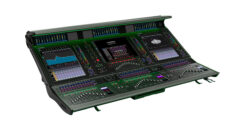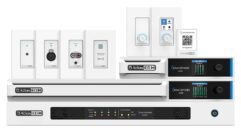

Ashly has a perfect example of the do-it-all power of audio DSP in their network-enabled NE DSP Processors such as the ne8800, which uses multiple SHARC 32-bit processors with sample rates of either 48KHz or 96KHz for its signal processing library. The units have a suite of customization and control features. The standard models are substantially configurable with four option bays housing network audio, AES3, and mic input options. The Protea Software Suite provides automatic microphone mixing, ambient noise sensing and level adjustment, autolevelers, compressors, matrix duckers, limiters, frequency-keyed noise gates, signal delay and sinewave, and pink or white noise generators. Control and programming are connected through Ethernet (with DHCP) and RS-232. Any function can be plugged into any channel block even when running live audio.
The BB-1616DT is one of the family of AtlasIED BlueBridge networkable DSP devices for videoconferencing, churches, courtrooms, restaurants, and many other applications. Once connected on a network, each BlueBridge processor is automatically recognized and controllable,providing processing tools such as a standard mixer, gain sharing auto-mixer, delays, equalizers, level controls, duckers, filters, and other capabilities. The BB-1616DT has 16 inputs and 16 outputs with Phoenix connectors, and it works with Atlas BluePanel software to create custom network accessible interfaces. AtlasIED offers preconfigured design templates that can be used as starting points. The unit can also be easily integrated into a Dante network. It features High Quality THAT mic preamps, four logic inputs/outputs and its generator modules include sine tone, sign sweep, white noise, and pink noise.

A whole family of audio digital signal processing products using Audio-Video Bridging (AVB), the Tesira line takes Biamp into the realm of very large platforms and now Tesira SERVER and SERVER-IO can use Dante (DAN-1 card), CobraNet (SCM-1 card), and AVB (AVB-1 card) in a single chassis. The DSP enables signal routing and mixing, equalization, filtering, dynamics, and delay, as well as control, monitoring and diagnostic tools; all configured through the Tesira design software. TesiraFORTÉ consists of four models each of which can be an AVB or non-AVB version. Controllable via Biamp Canvas interfaces, TesiraFORTÉ does not require a SERVER or SERVER-IO in order to function. All TesiraFORTÉ models can host Tesira TEC-1 control devices, EX-LOGIC devices and they can connect via Ethernet or RS-232 with third-party control systems.

The ControlSpace ESP-1240 engineered sound processor from Bose has 12×4 fixed analog audio channels, a built-in 8-channel ESPLink output and a rear-panel digital slot for IP based network audio and expansion. The inputs are mic and line level, and 16 digital inputs can be used through an optional card. The unit supports 48kHz, 24-bit audio, and among its options is a Dante media networking card. The built-in Bose ESPLink output sends up to eight channels of uncompressed digital audio to ESPLink-equipped Bose PowerMatch amplifiers while the unit can be configured and controlled via Ethernet. The Bose ControlSpace Designer software enables automatic mic mixing, graphic and parametric EQ, signal generators, routers, AGC, duckers, gates, and many more adjustable audio tools and parameters.

For sound reinforcement and conferencing support all the way up to large venues, ClearOne has the CONVERGE SR1212with a 12-input digital mixer, ALC and AGC, eight mic gating groups, 255 macros, and 32 presets. Matrix mixing parameters include 12 expansion bus in/outs, eight assignable processing blocks in/out and four assignable fader blocks in/out. There is also an event scheduler and diagnostic console along with SNMP and HTML remote management. The audio ports use push-on mini-terminal block connections. The configuration software allows drag-and-drop AV and channel objects, selectable views, and extensive customized configuration for natural sound and smooth interaction in any venue or environment.

The one-box solution to total sound reinforcement system control from Electro-Voice is the NetMax N8000 System Controllerwith its capability for up to 1900 MIPS of processing power and 32 local audio channels along with broad customization features and modular expansion. Managing all aspects of signal processing, supervision, and audio routing, the NetMax N8000 works on the Electro-Voice IRIS (Intelligent Remote Integrated Supervision) software platform and its local ports include RS232, Ethernet, CAN bus, GPIO, and four card slots, each of which can fit a single 8-channel input or output card. Any fault in the NetMax system can be logged and displayed on a PC screen or transmitted to any location. A visual map of the system is shown and the Web interface enables complete setup, control, and security.

The Extron DMP 128 12×8 ProDSP Digital Matrix Processorhas 12 mic/line inputs and eight outputs, eight channels of acoustic echo cancellation, and the AT models also offer eight inputs with FlexInput capability to select between analog or Dante inputs. The DMP 128 C P AT provides AEC, POTS, and Dante connectivity. Using the DSP Configurator Software, DMP 128 units can be configured through a flexible onscreen layout for DSP functions including level control, dynamics, filters, delay, ducking, loudness, feedback suppression, and matrix mixing. An expansion port allows any two DMP 128 models to be linked together via a single shielded Cat-6 cable. Each processor can be controlled through RS-232, Ethernet, or USB.

Hall Research has a perfect example of combining multiple functions into one box with the EMX-I-AMP, a 4K HDMI Audio Extractor with built-in 50W audio amplifier for direct connection of 8Ω speakers. It also features the ability to mix a line level audio signal with the HDMI audio output and to control the volume level from the front panel, RS-232, or an external digital rotary encoder pot that can be mounted on a wall plate. Other devices such as projectors and flatpanel displays can also be controlled through the secondary RS-232 connection. The EMX-I-AMP is the IP enabled version of the EMX-AMP, adding Ethernet control through a built-in WebGUI. Its full set of TELNET commands allows it to be integrated with third-party control systems.

The Soundweb London BLU-806from Harman’s BSS Audio provides primary and secondary Dante audio ports for fault tolerance while remote control connects through a separate Ethernet port. Its 256-channel audio buss uses Cat-5e for a distance of up to 100 meters between devices. Custom configurability is done with the system’s four card slots, each of which can accommodate any of six available I/O cards including analog in, analog out, digital in, digital out, AEC in, and a telephone hybrid card. The front panel has indicators for phantom power, sync, signal presence, and clip. The BLU-806 can interface with GPIO control through 12 control inputs while configuration, control, and monitoring can be done through HiQnet London Architect.
The Lectrosonics Aspen SPN Trio Wideband (SPNTWB)uses its Quad-reference Wideband Acoustic Echo Canceller and dual codec interfaces to perform as a stand-alone component for telepresence and audio conference systems and it can be expanded to include more inputs and outputs by combining it with additional ASPEN processors. These use a third octave dynamic processor as a proprietary noise reduction filter. The Ethernet port may be used for remote setup and control in addition to the RS-232 port. The final mix outputs from the matrix are fed to an internal amplifier to drive local speakers and the matrix processing includes parametric EQ, compression and limiting. The inputs are digitally programmable to accommodate line or mic level signals and they can be copied and pasted to duplicate processors across multiple channels. They can also be linked for more efficient stereo or global control.
For studio and live applications, the Dual DeltaFex from Peavey is a 2-channel multi-effects DSP unit with 24-bit stereo connections and it’s capable of operating in Series, Parallel, Dual Mono, and Sum Mono modes. Effects in its repertoire include multiple reverbs, delays, compressor, pitch shifter, chorus, flange, phase, tremolo, rotary speaker with morphing speed control, distortion, exciter along with karaoke, and there are two adjustable parameters for each effect. There are input and output level controls, mix control and a bi-color clip LED. The defeat jack doubles as a speed control for a rotary speaker. With this versatility, the Dual DeltaFex can operate with both channels linked or functioning as two completely separate and independent mono channels.



Sometimes the job calls for a simple and direct solution and Radio Design Labs (RDL) has the perfect answer for a three-band parametric equalizer or acoustic notch filter in the FP-PEQ3. The case is a FLAT-PAK design that can be screwed or bolted to cabinets or shelves. Each of its three filtered channels has a switch selectable boost/cut amplitude control with a 15dB range, a bandwidth knob to adjust from 0.04 octave to 1.5 octave, and frequency that is adjustable in overlapping ranges including 15Hz-200Hz, 150Hz-2kHz, and 1.5kHz-20kHz. The FP-PEQ3 has balanced and unbalanced inputs. The balanced connections accept and output line level signals on a plug-in terminal block while the unbalanced inputs are on RCA (phono) terminals. The front panel LED meter indicates -11dBu to +4dBu levels and the red LED lights at +4dBu to warn of overload. At 5.66in. long and 3.25in. wide, the unit is perfect for mounting in confined spaces.

The CP66 Commercial Processor from Rane includes a paging feature with its six inputs and six linkable zone outputs. While the USB connected Windows software provides the ability to save and load preconfigured settings, the unit can be set up through its front panel controls without using a computer. The system has six program inputs, four on RCA and two on balanced euroblock terminals. There are six independent and linkable zones, each of which has independent EQ, limiter, ducker depth, filter cutoff, priority enable, and page level per zone. The unit also has one gated Priority Input. Extra features include a transformer isolated music-on-hold output and a front panel lockout switch.

The Shure DFR22 Audio Processor is a 2-channel unit used for effective feedback reduction in sound reinforcement systems and it’s configured using a drag-and-drop graphical user interface. Its toolbox includes parametric and graphic equalizers, cut-shelf equalizer, compressor/limiters, automatic gain control, gate/downward expander, ducker, two-way crossover, subwoofer processor, splitter, delay processors and a 2×2 matrix mixer. The Windows-based software program mimics the functional block diagrams used in sound system design. The processing blocks in the DFR22 can be applied in any order, to any input or output. The DFR automatic feedback reduction uses five, 10, and 16-filter single channel and stereo modules.
Developed by Symetrix to provide sophisticated networked audio processing for installed sound applications, the Prism digital signal processing platform is available in 4×4, 8×8, 12×12, and 16×16 channel arrangements, and all are housed in a single rack unit chassis. Prism uses the same DSP, mic pre-amps and AD/DA converters that are built into the Symetrix Radius and Edge products. The Symetrix Composer Windows based CAD program can be used to configure and control each Prism processor. An embedded web server enables remote metering and diagnostics while the platform sends audio on the Dante protocol using standard IT infrastructure.


Another space-saving solution to audio mixing and processing is theA-5012digital mixer and power amplifier from TOA Electronics. Its two mic/line inputs connect on terminal blocks and their sensitivity is selected on an adjacent DIP switch. There is also a removable plug that lifts the ground on the unit to eliminate hum from ground loops. A manual muting function and a remote master volume control provide a means to remotely control the sound level. Using the A-5000 PC software, functions such as input equalizer, output equalizer, compressor, and remote master volume can be set through the LAN port. The output can be connected to use either high impedance (70V-100V) or low impedance loads.

For operating VUE loudspeaker systems, the VUE Audiotechnik V Series Systems Engines are 2U rack-mount amplifier/DSP processors that provide onboard SystemVUE networking and new Dante network audio inputs. Existing units are upgradable and the inputs can accommodate a wide range of signal levels. There are two models, the two-in/four-out V4 and the two-in/six-out V6, both of which are available in either the touring version with front panel LCD or the install version without the LCD. If the AES digital signal fails the unit will automatically revert to analog, using an input detection circuit. Once connected on a network, the V4 or V6 will automatically recognize and connect to virtually any kind of IP configuration.

Yamaha has the answer for conference centers, classrooms, shopping malls, and other such venues with the MRX7-D signal processor. To its acoustic echo canceller and automatic mic mixing capability, the unit adds built-in Dante digital audio networking. The dedicated MTX-RRZ Editor software allows input and output devices to be quickly arranged via a software wizard and internal MRX7-D processing components can be combined as needed. There are eight mono line and two stereo line inputs along with 64 in/out Dante capacity. The MRX7-D also offers one Mini-YGDAI card slot that can accommodate cards supporting a variety of audio formats, and expansion by up to 16 I/O channels. An SD memory card slot allows direct playback of MP3/WAV format audio files.











